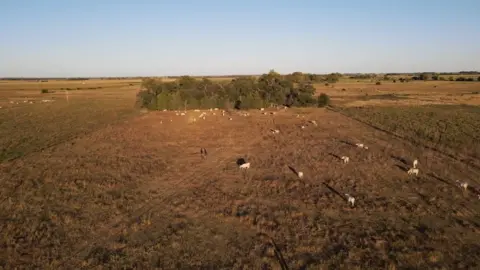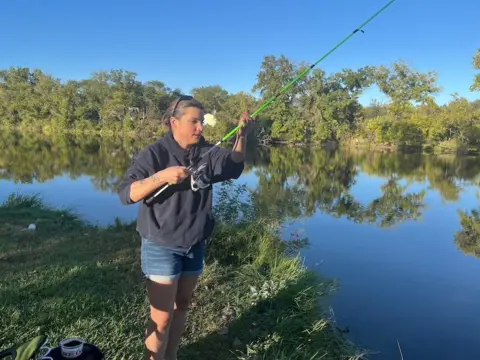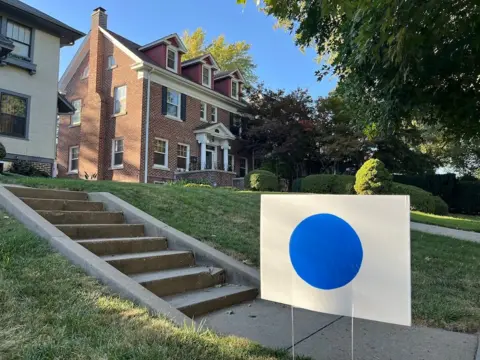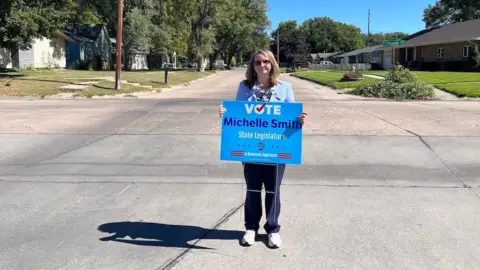 BBC
BBCIn this closely fought US election, vice-presidential candidates JD Vance and Tim Walz were picked to sway Midwestern and rural voters who might be hesitating over Donald Trump or Kamala Harris. In Nebraska, owing to an electoral quirk, such voters could prove pivotal.
As an expert breeder, Wade Bennett can tell you the precise parentage of every one of the 140 head of Charolais cattle he keeps on a small holding on the edge of Nebraska’s rolling Sandhills.
Despite being a staunch Republican, he’s less certain, however, of the pedigree of the man once again vying for his vote.
Donald Trump, he says, would probably be “kicked out” of his voting shortlist if there were other conservative options available.
One of the least-populated states, Nebraska is, like much of rural America, not only deeply Republican but deeply Christian, too. And some here, like Wade, are uncomfortable with what they see as Donald Trump’s personal, moral failings.
But with Kamala Harris and a smattering of small-party candidates the only other options this November, Wade is putting his scruples to one side.
“Even as a Christian,” he tells me. “It is what it is.”
He’s focusing not on Trump’s character, but on his policies – and he likes the promises he hears to crack down on illegal immigration, cut the cost of living and put more tariffs on trade.
Even his slight hesitation, however, is enough to give Democrats hope.

The rightward drift of the American countryside over the past 25 years has been remarkable.
In 2000, Republicans had a six-point advantage over Democrats among registered rural voters, according to the Pew Research Center.
But by 2024, they had established a mammoth 25-point lead.
Even though only a fifth of Americans live outside the big towns and cities, the strength of their shift towards Donald Trump was key to his victory against Hillary Clinton in 2016.
But for Democrats, the rural vote is still worth fighting for, particularly where even small gains in already tight states just might make the difference.
So it’s no coincidence that both Kamala Harris and Donald Trump now have running mates whose white rural roots are being used to make the argument for who is best placed to speak on behalf of this country’s great Midwest.
Vice-presidential candidates don’t usually have much impact on how people vote, but when Tim Walz and JD Vance meet in a primetime televised debate on Tuesday night, they will be hoping their different backstories and visions resonate with voters still unsure about Harris, a California Democrat, and Trump, a New York real estate developer.
Walz, the current governor of Minnesota, was born in small-town Nebraska, and has made much of his background “working cattle, building fence”.
His time as a schoolteacher and football coach before politics, and his subsequent record in Minnesota, providing tax credits to families and free school meals, are precisely the kinds of things the Democrats hope will resonate with struggling rural voters.
Ohio Senator Vance, on the other hand, is a man who’s also made much of his rural roots, but with a far less optimistic framing.
Vance rose to national prominence with his best-selling book, Hillbilly Elegy, the story of his family’s origins in eastern Kentucky, their struggle with poverty, his mother’s fight with addiction and the joblessness and blight of Middletown, Ohio, where he grew up.
Where Tim Walz has emphasised individual freedom and what binds Americans, Vance has focused on a “ruling class” that he says has failed working families in small communities all over the country.
In writings and in interviews, he has stressed the need for individual responsibility, rather than welfare – although he does not support cutting programmes like Social Security. And he echoes Trump’s vision of protecting American jobs and workers with tariffs and border walls.
I meet 42-year-old Shana Callahan casting for catfish under a setting sun in the Two Rivers Recreation Area, just outside the city of Omaha. The cost of living, once again, is never far from mind.
“Everything costs more, everything sucks,” she says.
“I drive an F-150 and when Trump was in office, I was paying about 55 bucks for a tank of gas. Right now, it’s anywhere between 85 to 109, and, you know, the cost of groceries and everything has just gone through the roof.”
There were structural reasons for the depressed oil market during some of Trump’s presidential term, not least the Covid crisis, and prices had begun to climb steeply before he left office. Some economists also say President Joe Biden’s 2021 stimulus spending contributed to broader inflation.
But economics is a feeling in US elections, not a graph on a page, and Shana has made up her mind.
There’s nothing, she tells me, that would convince her to vote for Kamala Harris, especially not Tim Walz’s local backstory and his claims to represent people like her.
“For one thing, the man’s a goofball,” she says. “I can’t respect him. He comes out on the freaking stage like, ‘Oh, go, coach’.”
The story of JD Vance being raised by a grandmother because of the opioid crisis – which she knows from the film version of his book – resonates deeply, however.
“The beginning of the movie is like, you know, family is always going to back you up. I mean, that’s kind of the way it is out here.”
“I’m only 42 and I’ve had like, three friends die of fentanyl.”

Shana lives in the one small part of this vast, rural state that may find itself with an outsized impact on November’s election result.
Under the US system, each state is allocated a specific number of votes in what’s known as the electoral college. Presidential candidates need to reach 270 votes to win the White House.
Unlike most of the rest of America, where all the electoral college votes in each state go to the winner of the popular vote, Nebraska does things differently.
Three of its five votes are decided by whoever wins three individual districts.
Nebraska is a reliably Republican state but its second district – worth one vote – went to Trump in 2016, to Biden in 2020, and this time round there’s a scenario in which whoever wins it could win the whole election.
If Harris wins the Rust Belt swing states of Pennsylvania, Michigan and Wisconsin and Trump takes the Sun Belt states of Georgia, North Carolina, Arizona and Nevada then the second district would provide the single tie-breaking vote.
District two is a microcosm of America, with the heavily Democrat-leaning city of Omaha balanced by the Republican-leaning outskirts and the countryside beyond.
In their backyard in the centre of Omaha, Jason Brown and Ruth Huebner-Brown are spraying giant blue dots on plain white lawn signs.
“We’re like a little swing state within a state,” Jason tells me. “It could absolutely, I guess you would say, be a history-changing moment. This could really be the ultimate one vote that matters.”
In an effort to keep the “blue dot” blue, the Harris-Walz campaign has been massively outspending Trump-Vance here, pouring millions into TV advertising.
Ruth tells me she believes it’s having an effect on the doorsteps.
“When they talk about Walz he’s very relatable. He’s, you know, one of us. And, you know, they just trust him.”
“And I think a lot of people are very tired of the divisiveness and the bitterness and he’s, he’s anything but that.”

There’s plenty of divisiveness in Nebraska.
Even here, deep in the American countryside, you can hear the unsubstantiated assertions that large numbers of immigrants are unlawfully claiming Social Security or engaging in ballot fraud.
One Republican voter admits his belief in such claims is based not on fact, but on what he’s heard, with echoes of JD Vance’s similar justification for his promotion, without evidence, of the allegation that Haitian migrants are eating pets in Ohio.
A soybean farmer tells me that Kamala Harris is a “DEI hire”; another says it is white people who are being discriminated against in today’s America.
Yet, on the Democratic side, there are signs of groupthink too – the bafflement over the choices of their opponents and a readiness to see all Republican voters as motivated by the narrow politics of prejudice.
But there’s something else unique about Nebraska’s electoral system. Its state legislature is nonpartisan, meaning it does not recognise the party affiliations of its elected members nor organise them around formal party voting blocs.
In the city of Hastings, Michelle Smith is out canvassing for a seat in that local legislature.
She’s a Democrat fighting for votes in a very red district, but, she says, the system encourages compromise.
“My own father is one of those people who’s going to vote for Donald Trump, and I understand it,” she tells me.
“I’m a business owner. I paid less taxes when Donald Trump was president. Our prices were lower at the grocery store.”
How does she campaign?
“I bring it down to the local issues. I’m not a national candidate. I’m a local candidate, and I’m running to make things better here in Nebraska.”

For now, Nebraska is very much in the national spotlight.
There’s been a last-minute attempt by the Republican Party not to leave anything to chance, with several lawmakers pushing for a move to make the state a winner-takes-all system.
Barring the completely unexpected, that would mean all the state’s electoral college votes go to Donald Trump.
It foundered, though, on the opposition of a few local Republican senators, who refused to bow to the pressure this close to an election, placing what they saw as the interests of the state – given the rare bit of political leverage the system provides – over that of national partisan politics.
Even Lindsey Graham, the powerful Republican senator, flew in to meet with the holdouts, but to no avail.
“It was interesting,” he’s reported to have said back in Washington. “They have a different system. Everybody’s like a mini-governor.”
Whether or not Nebraska plays an outsized role in November’s deeply divided contest, it may offer something of an alternative to it.

More on the US election



